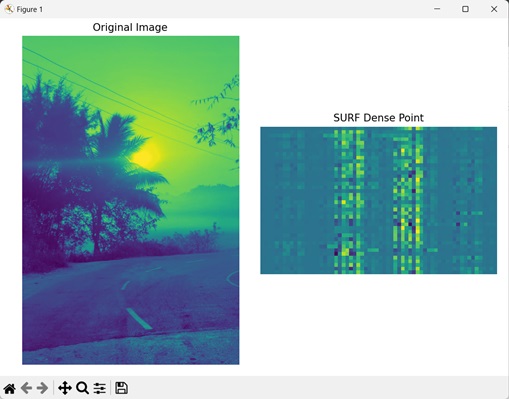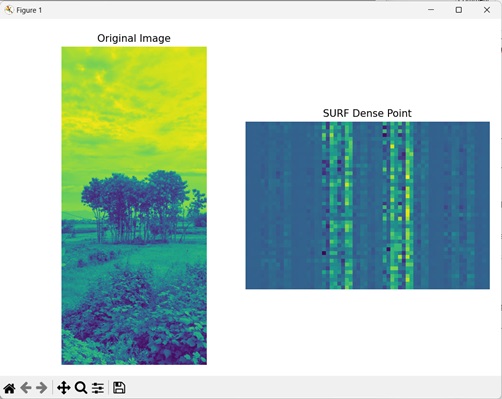
- Mahotas教程
- Mahotas - 首頁
- Mahotas - 簡介
- Mahotas - 計算機視覺
- Mahotas - 歷史
- Mahotas - 特性
- Mahotas - 安裝
- Mahotas影像處理
- Mahotas - 影像處理
- Mahotas - 載入影像
- Mahotas - 以灰度載入影像
- Mahotas - 顯示影像
- Mahotas - 顯示影像形狀
- Mahotas - 儲存影像
- Mahotas - 影像質心
- Mahotas - 影像卷積
- Mahotas - 建立RGB影像
- Mahotas - 影像尤拉數
- Mahotas - 影像中零的比例
- Mahotas - 獲取影像矩
- Mahotas - 影像區域性最大值
- Mahotas - 影像橢圓軸
- Mahotas - 影像拉伸RGB
- Mahotas顏色空間轉換
- Mahotas - 顏色空間轉換
- Mahotas - RGB到灰度轉換
- Mahotas - RGB到LAB轉換
- Mahotas - RGB到褐色轉換
- Mahotas - RGB到XYZ轉換
- Mahotas - XYZ到LAB轉換
- Mahotas - XYZ到RGB轉換
- Mahotas - 增加伽馬校正
- Mahotas - 拉伸伽馬校正
- Mahotas標記影像函式
- Mahotas - 標記影像函式
- Mahotas - 標記影像
- Mahotas - 過濾區域
- Mahotas - 邊界畫素
- Mahotas - 形態學運算
- Mahotas - 形態學運算元
- Mahotas - 查詢影像均值
- Mahotas - 裁剪影像
- Mahotas - 影像離心率
- Mahotas - 影像疊加
- Mahotas - 影像圓度
- Mahotas - 調整影像大小
- Mahotas - 影像直方圖
- Mahotas - 膨脹影像
- Mahotas - 腐蝕影像
- Mahotas - 分水嶺演算法
- Mahotas - 影像開運算
- Mahotas - 影像閉運算
- Mahotas - 填充影像空洞
- Mahotas - 條件膨脹影像
- Mahotas - 條件腐蝕影像
- Mahotas - 影像條件分水嶺演算法
- Mahotas - 影像區域性最小值
- Mahotas - 影像區域最大值
- Mahotas - 影像區域最小值
- Mahotas - 高階概念
- Mahotas - 影像閾值化
- Mahotas - 設定閾值
- Mahotas - 軟閾值
- Mahotas - Bernsen區域性閾值化
- Mahotas - 小波變換
- 製作影像小波中心
- Mahotas - 距離變換
- Mahotas - 多邊形工具
- Mahotas - 區域性二值模式
- 閾值鄰域統計
- Mahotas - Haralick特徵
- 標記區域的權重
- Mahotas - Zernike特徵
- Mahotas - Zernike矩
- Mahotas - 排序濾波器
- Mahotas - 二維拉普拉斯濾波器
- Mahotas - 多數濾波器
- Mahotas - 均值濾波器
- Mahotas - 中值濾波器
- Mahotas - Otsu方法
- Mahotas - 高斯濾波
- Mahotas - Hit & Miss變換
- Mahotas - 標記最大值陣列
- Mahotas - 影像均值
- Mahotas - SURF密集點
- Mahotas - SURF積分影像
- Mahotas - Haar變換
- 突出影像最大值
- 計算線性二值模式
- 獲取標籤邊界
- 反轉Haar變換
- Riddler-Calvard方法
- 標記區域的大小
- Mahotas - 模板匹配
- 加速魯棒特徵(SURF)
- 移除邊界標記
- Mahotas - Daubechies小波
- Mahotas - Sobel邊緣檢測
Mahotas - SURF密集點
SURF(加速魯棒特徵)是一種用於檢測和描述影像中興趣點的演算法。這些點被稱為“密集點”或“關鍵點”,因為它們密集地分佈在整個影像中,不像稀疏點只出現在特定區域。
SURF演算法以不同的尺度分析整個影像,並識別強度變化顯著的區域。
這些區域被認為是潛在的關鍵點。它們是包含獨特且顯著模式的感興趣區域。
Mahotas中的SURF密集點
在Mahotas中,我們使用mahotas.features.surf.dense()函式來計算SURF密集點的描述符。描述符本質上是特徵向量,描述了影像中畫素的區域性特徵,例如它們的強度梯度和方向。
為了生成這些描述符,該函式在影像上建立一個點網格,每個點之間保持一定的距離。在網格中的每個點上,都會確定一個“興趣點”。
這些興趣點是捕獲影像詳細資訊的位置。一旦識別出興趣點,就會計算密集的SURF描述符。
mahotas.features.surf.dense()函式
mahotas.features.surf.dense()函式以灰度影像作為輸入,並返回一個包含描述符的陣列。
這個陣列通常具有這樣的結構:每一行對應一個不同的興趣點,列代表該點的描述符特徵值。
語法
以下是Mahotas中surf.dense()函式的基本語法:
mahotas.features.surf.dense(f, spacing, scale={np.sqrt(spacing)},
is_integral=False, include_interest_point=False)
其中,
f - 輸入灰度影像。
spacing - 確定相鄰關鍵點之間的距離。
scale(可選) - 指定計算描述符時使用的間距(預設為間距的平方根)。
is_integral(可選) - 一個標誌,指示輸入影像是整數還是浮點數(預設為'False')。
include_interest_point(可選) - 一個標誌,指示是否與SURF點一起返回興趣點(預設為'False')。
示例
在下面的示例中,我們使用mh.features.surf.dense()函式計算影像的SURF密集點。
import mahotas as mh
from mahotas.features import surf
import numpy as np
import matplotlib.pyplot as mtplt
# Loading the image
image = mh.imread('sun.png')
# Converting it to grayscale
image = mh.colors.rgb2gray(image)
# Getting the SURF dense points
surf_dense = surf.dense(image, 120)
# Creating a figure and axes for subplots
fig, axes = mtplt.subplots(1, 2)
# Displaying the original image
axes[0].imshow(image)
axes[0].set_title('Original Image')
axes[0].set_axis_off()
# Displaying the surf dense points
axes[1].imshow(surf_dense)
axes[1].set_title('SURF Dense Point')
axes[1].set_axis_off()
# Adjusting spacing between subplots
mtplt.tight_layout()
# Showing the figures
mtplt.show()
輸出
以下是上述程式碼的輸出:

透過調整尺度
我們可以調整尺度來計算不同空間中SURF密集點的描述符。尺度決定了圍繞興趣點檢查的區域大小。
較小的尺度適用於捕獲區域性細節,而較大的尺度適用於捕獲全域性細節。
在Mahotas中,surf.dense()函式的scale引數決定了計算SURF密集點描述符時使用的縮放比例。
我們可以為此引數傳遞任何值來檢查縮放對SURF密集點的影響。
示例
在下面提到的示例中,我們正在調整尺度以計算SURF密集點的描述符:
import mahotas as mh
from mahotas.features import surf
import numpy as np
import matplotlib.pyplot as mtplt
# Loading the image
image = mh.imread('nature.jpeg')
# Converting it to grayscale
image = mh.colors.rgb2gray(image)
# Getting the SURF dense points
surf_dense = surf.dense(image, 100, np.sqrt(25))
# Creating a figure and axes for subplots
fig, axes = mtplt.subplots(1, 2)
# Displaying the original image
axes[0].imshow(image)
axes[0].set_title('Original Image')
axes[0].set_axis_off()
# Displaying the surf dense points
axes[1].imshow(surf_dense)
axes[1].set_title('SURF Dense Point')
axes[1].set_axis_off()
# Adjusting spacing between subplots
mtplt.tight_layout()
# Showing the figures
mtplt.show()
輸出
上述程式碼的輸出如下:

透過包含興趣點
在計算SURF密集點的描述符時,我們也可以包含影像的興趣點。興趣點是畫素強度值發生顯著變化的區域。
在Mahotas中,為了包含影像的興趣點,在計算SURF密集點的描述符時,我們可以將include_interest_point引數設定為布林值'True'。
示例
在這裡,我們在計算影像SURF密集點的描述符時包含了興趣點。
import mahotas as mh
from mahotas.features import surf
import numpy as np
import matplotlib.pyplot as mtplt
# Loading the image
image = mh.imread('tree.tiff')
# Converting it to grayscale
image = mh.colors.rgb2gray(image)
# Getting the SURF dense points
surf_dense = surf.dense(image, 100, include_interest_point=True)
# Creating a figure and axes for subplots
fig, axes = mtplt.subplots(1, 2)
# Displaying the original image
axes[0].imshow(image)
axes[0].set_title('Original Image')
axes[0].set_axis_off()
# Displaying the surf dense points
axes[1].imshow(surf_dense)
axes[1].set_title('SURF Dense Point')
axes[1].set_axis_off()
# Adjusting spacing between subplots
mtplt.tight_layout()
# Showing the figures
mtplt.show()
輸出
執行上述程式碼後,我們將獲得以下輸出:
